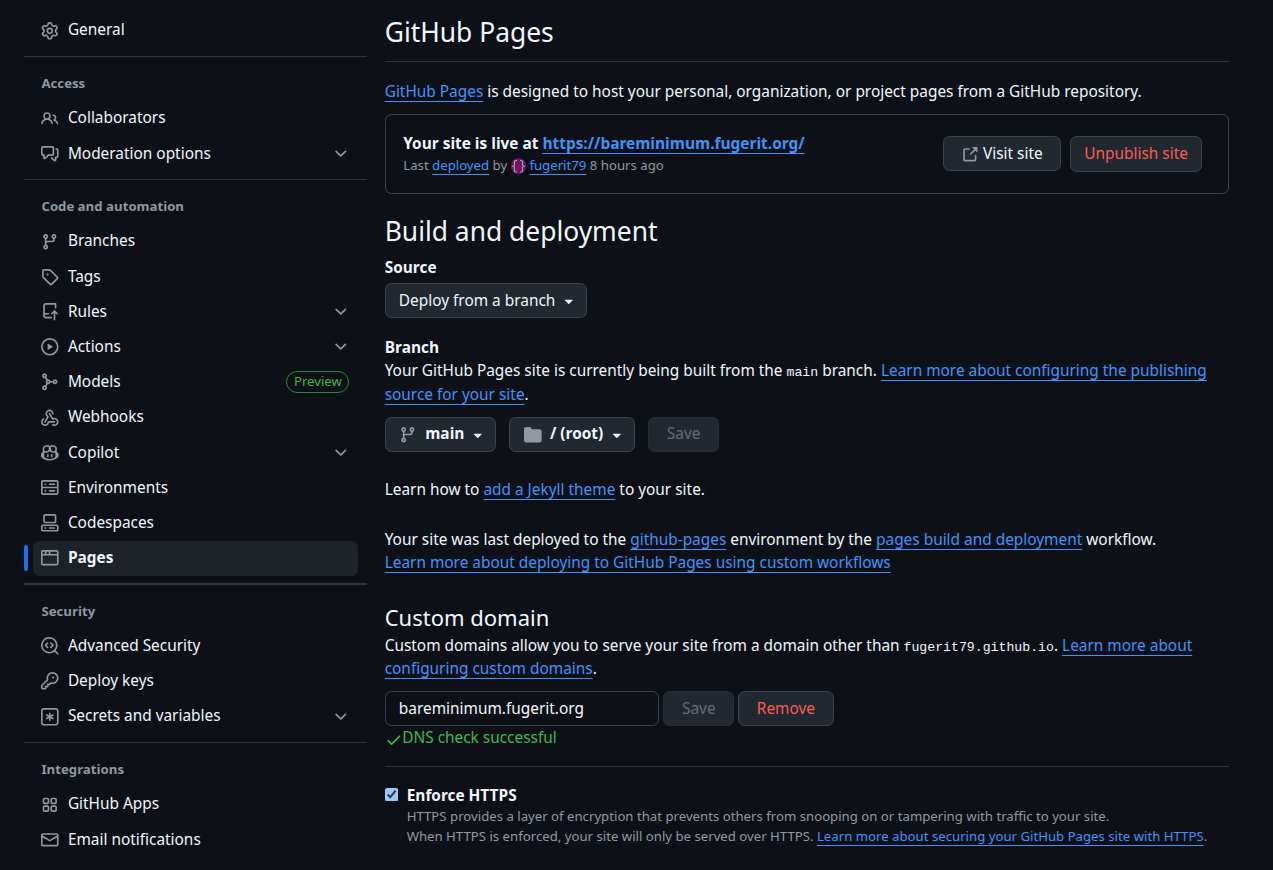bare-minimum-github-repo
Base Minimum GitHub repo
Minimum quality guidelines for maintainable GitHub projects.
Note: While focused on GitHub, most of these guidelines apply to any software project regardless of platform.
1. Documentation (README.md)
Documentation is the most important aspect of every project if you want to make it usable by others. (but keep in mind that after some time you may need documentation as well).
Most of the time a complete readme (like the one you are reading now) could be enough for a GitHub project .
Writing the correct amount of information in documentation can be tricky. Too much to read and most people may struggle finding what they need. Too few and you may miss something important.
[!TIP] 📚 Documentation Testing
Treat your docs like code—test them! Have a fresh user attempt setup using only your README. Their success = good docs. Their struggles = your roadmap for improvements.
2. Changelog
A changelog makes it easier for users and contributors to see the notable changes to the project.
It is possible to use any format, but I like Olivier Lacan’s Keep a changelog guidelines.
Refer to Keep a changelog site for more information.
Key principles:
- Don’t dump git logs - Curate meaningful changes, not commit messages
- State your versioning model - Use Semantic Versioning and stick to it
- Be consistent - Define what counts as “notable” and apply that standard throughout
[!TIP] 🔖 Changelog appearance
I like key features like changelog to be very visible. Maybe using a badge or something similar to it :
3. Requirements
Clearly state your project’s requirements so users know what they need before getting started.
[!TIP] 📋 Choose the right format
Use badges when you have 2-3 simple requirements. Switch to a table when you need to explain optional dependencies, version ranges, or platform-specific details.
Simple requirements with badges:
Complex requirements with a table:
| Requirement | Version | Note |
|---|---|---|
| java | 21+ | always required |
| maven | 3.9+ | always required |
| docker | 27+ | optional, needed for container version |
4. Publishing documentation
Publishing your documentation makes it easily accessible to users. GitHub Pages is a simple, free way to host your docs.
Basic setup:
- Go to your repository Settings
- Navigate to Pages
- Under Branch, select your branch (e.g.,
main) - Click Save

This will publish with the default domain :
https://${github-org}.github.io/${github-repo}/
Custom domain (optional):
You can configure a custom domain in the same Pages settings.

Here is the result https://bareminimum.fugerit.org/
[!TIP] 🌐 Make your documentation discoverable
Add a badge linking to your published docs so users can find it instantly:
5. License
A software license tells others what they can and can’t do with your source code, so it’s important to make an informed decision.
If unsure, there are many resources that can help:
For software projects: Use Choose an open source license to find the right license for your code.
Read GitHub’s Licensing a repository article for implementation details.
For documentation and content: Creative Commons licenses are ideal. Try the Creative Commons Chooser to pick the right one.
[!TIP] ⚖️ Display your license prominently
Add a badge so users can quickly see your licensing terms:
6. Code of conduct
Adopt a code of conduct to define community standards, signal a welcoming and inclusive project, and outline procedures for handling abuse.
Refer to GitHub docs article for more information.
I usually adhere to the Contributor Covenant philosophy from EthicalSource.
[!TIP] 🤝 Make your code of conduct visible
Add a badge linking to your code of conduct so contributors know your community standards:
7. Continuous integration (CI)
Automate essential quality checks with continuous integration. At minimum, your CI should build and test your code on every commit.
GitHub Actions makes this easy - create a .github/workflows/ directory and add a workflow file. Check GitHub’s starter workflows for templates in your language.
Recommended checks:
- Build verification
- Automated tests
- Code linting
[!TIP] ✅ Display your CI status
A passing build badge shows users your project is well-maintained:
8. Code review
Automated code quality tools help catch bugs, security vulnerabilities, and code smells before they reach production.
Popular choices:
- SonarQube Cloud - Comprehensive code analysis
- Snyk - Security and dependency scanning
- Codacy - Automated code reviews
- Dependabot - Find and fix vulnerable dependencies you rely on
Most of these tools integrate easily with GitHub Actions and offer free tiers for open-source projects.
[!TIP] 🔍 Show your code quality
Display quality badges to demonstrate your commitment to clean, secure code:
9. Test Coverage
Tests are important to ensure code quality and avoid regressions. Test coverage measures the percentage of your code that’s actually executed by your tests.
Generating coverage:
Most testing frameworks have built-in coverage tools:
- JavaScript/TypeScript: Jest, c8, nyc
- Python: pytest-cov, coverage.py
- Java: JaCoCo, Cobertura
- Go: Built-in with
go test -cover
Many CI tools like SonarQube, Codecov, and Coveralls can track coverage over time and integrate with pull requests.
What’s a good target?
While 100% coverage isn’t always practical or necessary, aim for:
- Critical business logic: 80%+ coverage
- Overall project: 70%+ coverage
Focus on testing important paths rather than chasing arbitrary coverage numbers.
[!TIP] 📊 Display your coverage
Use a badge to show your coverage percentage :
10. Conventions and Guidelines
Clear conventions make contributing easier and maintain code consistency.
Key documentation:
- CONTRIBUTING.md - How to contribute, coding standards, PR process
- SECURITY.md - How to report vulnerabilities responsibly
- .editorconfig - Consistent formatting across different editors
Code style:
Use automated formatters (Prettier, Black, gofmt) and document any project-specific conventions.
See GitHub’s Setting up your project for healthy contributions guide.
[!TIP] 🤝 Lower the contribution barrier
A good CONTRIBUTING.md should cover:
- Development setup steps
- How to run tests locally
- Commit and PR guidelines
- Where contributors can get help






